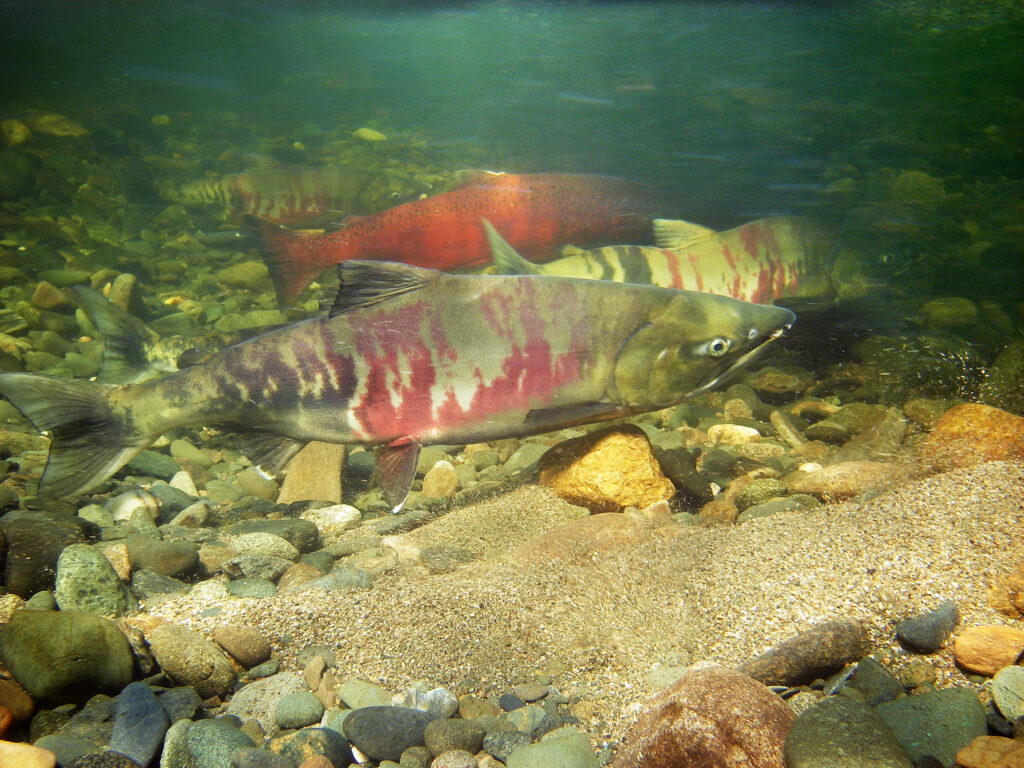Migrating summer chum and Chinook salmon are seen on July 7, 2007, in the Tozitna River, a Yukon River tributary. While salmon returns in the Yukon River continued to be weak this year, there were some signs of improvement, including a better-than-expected return of Chinook to Canada. (Photo by Jason Post/U.S. Bureau of Land Management)
Salmon numbers in the Yukon River and its tributaries remained low this year, continuing a yearslong trend of struggles and harvest closures, but there were some positive signs, according to late-season information from Alaska and Canadian fisheries managers.
The fall run of chum salmon, which usually comes into the river system from mid-July to October, is the third lowest in a record that goes back to the 1970s, the Alaska Department of Fish and Game said in a Yukon River update issued on Wednesday. It is expected to be less than a quarter of the historic average of about 900,000 fish, the update said.
The Yukon River coho salmon run, which is typically smaller and of shorter duration, was also poor this year, the third lowest in a record that goes back to the 1990s, the department’s update said.
However, the summer run of chum salmon, which arrived in the river system earlier, was strong enough this year to allow some subsistence harvests, albeit with various gear restrictions and a requirement that any Chinook salmon that were caught be returned to the water alive.
Subsistence fishing was allowed in both state-managed segments and federally managed segments of the Yukon River system. And it was allowed during the period when the two runs were overlapping.
Subsistence harvests of chum salmon from the summer run were allowed last year as well, after the return emerged as better than forecast.
While runs are low – and are failing to meet treaty targets for returns into Canada — there has been some marginal improvement since the worst period a few years ago, official reports show
“We hit rock bottom in 2021 for all species on the Yukon,” said Christy Gleason, an Alaska Department of Fish and Game area biologist for the Yukon River region.
There were upticks even for the river’s troubled Chinook salmon runs. As of Sept. 19, 24,112 of the fish had reached the Alaska-Canada border, according to the most recent update from Fisheries and Oceans Canada.
That is well below the goal of a 71,000-fish target in the U.S.-Canada Yukon River Salmon Agreement. But it is well above the 14,752 Chinook that made it that far up the river last year and the 13,000 total predicted in this year’s preseason forecast, according to the update.
A rainbow arcs over the Yukon River near Eagle in this undated photo. Eagle is an Alaska community near the Canadian border. A U.S.-Canada agreement aims for 71,000 Chinook salmon to swim into Canada past the border; this year’s return to Canada fell far short of that target but was significantly better than the return last year. (Photo provided by U.S. Geological Survey)
Fewer fall chum salmon had reached the Yukon River’s Canadian border than the total counted the same time last year, however, Fisheries and Oceans Canada said.
The summer chum salmon run, which generally returns in the period leading up to mid-July, has presented a brighter picture than the fall run, which generally starts in mid-July and runs to October.
The runs differ more in the timing of their entry into the Yukon River system, Gleason said.
The summer run is bigger and has a different age composition, she said. While both have a mix of 4-year-old and 5-year-old fish, the summer run’s mix is more even while the fall run tilts heavily to the older fish, she said.
That is important because the older fish are part of an age group that was especially hard-hit by poor ocean conditions triggered by warmer temperatures, she said.
Federal and state scientists have found evidence that extreme marine heatwaves in the Bering Sea from 2014 to 2019 harmed the chum salmon that were in the ocean at the time.
Problems in the saltwater environment appear to be lingering, Gleason said. “The ocean conditions aren’t really improving, so we’re not seeing improvement in the fall chum,” she said.
Another difference between the summer and fall chum runs concerns spawning areas. The fall chum spawn much farther upstream in the Yukon River system, including in the Canadian headwaters, according to the U.S. Fish and Wildlife Service.
An additional factor hindering recovery of the fall chum salmon run could stem from that reliance on Canadian headwaters
An abrupt change in Canadian river habitat, resulting from extreme glacial retreat in 2016, created a case of what scientists termed “river piracy” that wiped out an important chum-spawning site.
That event is tied to climate change. It happened when Canada’s Kaskawulsh Glacier retreated so much that it stopped sending water to one of the two rivers it previously fed. The Slims River, which fed the Yukon River system, was the loser, and the water was instead diverted to the Kaskawulsh River, which flows into the Gulf of Alaska rather than the Bering Sea.
SUPPORT NEWS YOU TRUST.

